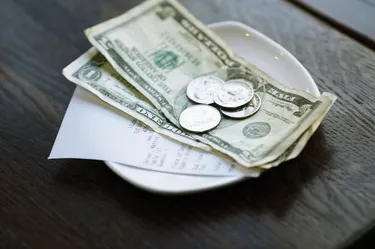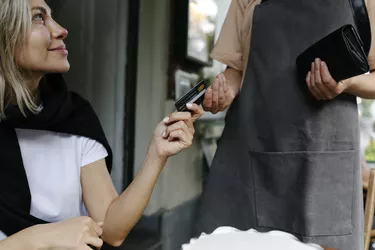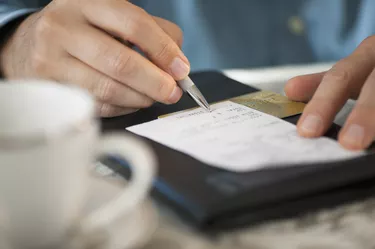Paying for a meal at a restaurant with a credit card is a simple and convenient process that millions of people do every day. However, if you’ve just gotten your first credit card, the idea of handing it over to pay for dinner may seem a bit intimidating at first. Not to worry! With this comprehensive guide, you’ll learn the ins and outs of using a credit card to settle your restaurant tab smoothly and easily.
Overview of the Process
Here’s a quick rundown of what to expect when paying for a restaurant meal with your card
- The server brings the check in a folder or check presenter and leaves it on the table.
- Review the bill to ensure there are no errors.
- Calculate a tip amount based on the service quality.
- Let the server know if you need change for cash tip.
- Hand the server your card or take it to the register.
- The staff will process your card payment.
- You’ll receive an itemized receipt to review.
- On the receipt, add tip, total it up, and sign your name.
- Keep the customer copy for your records.
Now let’s take a closer look at each step of paying your restaurant bill with a credit card
Reviewing Your Bill
When your server drops off the check at your table, take a moment to carefully look over the listed charges. Verify that all the items match what you and your party ordered – appetizers, entrees, drinks, desserts, etc. Check for any duplicate charges or items you didn’t order.
If you notice any discrepancies on the bill, point them out to your server right away. It’s much easier to get errors corrected on the spot rather than trying to deal with an inaccurate charge later.
Calculating The Tip
Once you confirm the bill total is correct, it’s time to figure out your tip. Tipping 15-20% of the pretax amount is standard restaurant etiquette in the US. Servers rely on tips as the majority of their income.
Here are some simple ways to calculate 15-20%:
- Move the decimal point one place left on the bill total – that’s 10%. Double it for 20%.
- Divide the bill total by 5 for 20% or 6 for 15%. Round up.
- Use the tip calculator on your phone’s app.
For exceptional service, tip over 20%. For poor service, tip under 15%.
Getting Cash Back For The Tip
If you want to leave some or all of the tip in cash, let your server know before they take your card. Ask them to bring back $20, $40, etc. in change so you can leave the cash on the table. They’ll deduct it from your card payment when they process it.
Handing Off Payment
The process of handing off your credit card varies by restaurant. At some places, you’ll keep the check at your table for the server to pick up. Tell them you’re ready to settle up and hand over your card.
At casual eateries or cafes, you may take the check presenter up to the register and pay there. The staff will process your card payment at the counter.
Either way, only hand your card directly to a staff member. Never leave it unattended on an empty table.
Getting Your Card Processed
The server or cashier will take your card to process payment. They may ask to see your ID to verify it’s yours. The card will be inserted or tapped at the point-of-sale terminal, which connects to your card network to authorize the transaction amount.
You’ll get your card back right away – it does not stay with the restaurant. The authorized hold reserves the funds until the charge finalizes when they batch out at the end of the day.
Reviewing The Itemized Receipt
After your card is processed, you’ll receive a printed receipt listing your charges in detail. It will show the restaurant name, date, time, payment method, and itemized list of everything purchased.
Double check that all items match your order and the total is correct. The subtotal, tax, and final amount due will be printed at the bottom.
Adding Tip & Signing The Total
There will be a blank line on the receipt to write in your tip amount. Add the tip to the subtotal. Then write the grand total on the “total” line and sign your name below.
Your signature authorizes the final charge. Make sure it matches the one on your card. Add tip based on the subtotal, not the total with tax.
Keeping Your Receipt Copy
The restaurant will provide two identical receipts – one marked “merchant copy”, one marked “customer copy”. Keep the one marked “customer copy” for your records.
Having your receipt allows you to verify later that your statement shows the correct charge. It also documents your tip amount should you need that for any reason.
Tracking The Charge
It usually takes 1-3 days for restaurant charges to post to your credit card account. Check your online statement or use your card issuer’s app to monitor pending activity.
The charge will display as “pending” until it fully processes. Make sure the final posted charge exactly matches your receipt. Report any discrepancies to your card issuer ASAP.
Paying Your Bill If The Card Reader Is Down
If the restaurant’s payment systems are down, they may be unable to process your card. In this case, ask if they can invoice you or securely store your card info to charge later when systems are back up. As a last resort, you can leave your ID and return later to pay. Only do this at reputable establishments you trust.
Leaving The Table Before Paying
It’s best not to leave your table to visit the restroom, take a call, etc. until after paying your bill. But if you must, let your server know in advance and leave your card or ID with them. Never leave without communicating this, as the staff will assume you’ve dined and dashed.
Splitting The Check With Friends
If you’re splitting the check with others, tell your server upfront so they can print separate checks. If you forgot to do this, ask the staff to split it for you after the fact. With separate checks, you can each pay individually with different cards.
For one collective bill, divide it evenly or by what each person ordered. Use card apps like Venmo or CashApp to send money to whomever paid the full amount.
Paying Your Bill With Multiple Cards
If you want to pay one bill with two cards, let your server know in advance. When they bring the check, they can run half on one card, half on the other. Write which card paid which portion on the receipt.
You can also pay the entire bill with one card, then get cash back on a second to reimburse the first cardholder.
Leaving A Cash Tip
If you tipped with your card but want to leave additional cash for great service, only do so after signing your receipt. Otherwise, the server has no way of knowing you’ll leave cash and may think you stiffed them.
Never take back the tip you already wrote on the receipt – that signed amount is set in stone. Only leave extra cash on top of the original tip.
Handling A Disputed Charge
If you notice an incorrect restaurant charge on your statement, report it immediately to your card issuer. Provide details like the receipt, date, amount, and explanation. They will initiate a dispute to remove invalid charges from your account.
Only dispute legitimate errors – don’t dispute a charge simply because you regret an expensive meal or forgot you dined there!
Using Credit Cards At Restaurants
Paying with a credit card offers important benefits compared to using cash at restaurants:
- You don’t need to stop for cash before dining out.
- There’s no calculating exact change or rounding up bills.
- You earn rewards points to redeem for cash back or other perks.
- You have protections if your card number is compromised.
- You have a record of the transaction if you need to dispute a charge.
Just don’t forget your card when going out to eat – nobody wants to end up washing dishes! By understanding the process and following these tips, you can smoothly pay your restaurant bill with your credit card every time.

Paying Your Restaurant Bill
Video of the Day
Paying a restaurant bill with a credit card is very straightforward. First, your server will leave the bill with you on the table. Look the bill over and make sure the charges are accurate. Depending on the restaurant, you may hand the bill to the waiter, or you might take it up to a cash register to pay in person.



Video of the Day
Your server will be able to tell you how this works. Either way, the person responsible will take your credit card, ring up your charges and present you with a printed receipt.
Filling Out Your Receipt
The receipt you receive documents the date and time of the purchase, as well as what method you used to pay for it. The receipt will also show you the amount youre being charged for the meal, as well as its taxes. In most restaurants, therell be a line for a tip or gratuity. If youre charging a tip on the card, youll need to write the tips value into that line, then add it to the cost of the meal to get the final total to be charged to the card and sign underneath. This is what gives the restaurant permission to charge the meal to your card.



The restaurant will likely provide two copies of the receipt. One will denote itself as the customer copy at the top or bottom – this is a copy for your records. You can remind yourself what you tipped and what the total charge is if you choose to check the charge on your bill to make sure it matches. The restaurant will keep the other copy of the receipt for its records.
How to Pay at a Restaurant with a Card
FAQ
Can I pay a restaurant bill with a credit card?
How does paying with a credit card work at a restaurant?
How to pay with card at sit down restaurant?
Is there a way to pay a bill with a credit card?
Are credit cards a good way to pay restaurant bills?
When it comes to dining out, credit cards have become a popular form of payment. With their convenience and security features, credit cards offer a hassle-free way to settle restaurant bills. However, if you’re new to using credit cards at restaurants, you may have some questions about the process.
How do you pay a restaurant bill?
Depending on the restaurant, you may hand the bill to the waiter, or you might take it up to a cash register to pay in person. Your server will be able to tell you how this works. Either way, the person responsible will take your credit card, ring up your charges and present you with a printed receipt.
How does a restaurant pay a credit card?
The credit card issuer pays the restaurant on your behalf, and you repay the issuer at a later date, either in full or through monthly installments. It’s important to note that credit card payments can incur interest charges if you carry a balance from month to month.
How do I use my credit card at a restaurant?
If the restaurant uses portable payment devices or electronic tablets for payment processing, you may be able to swipe or insert your credit card directly into the device. Follow the instructions provided by the server or on the payment device itself to complete the transaction securely.
Should you pay your bill at the end of a restaurant meal?
For most diners, paying one’s bill at the finish of a restaurant meal is a simple, uncomplicated process, a no-brainer. Or should be. It never fails to amaze me how many people screw this up. The ideal execution of bill getting-and-paying should be a near-non-event.
Can you tip a restaurant with a credit card?
Tipping with a credit card in a restaurant usually follows a simple process: Ask for the bill. Look over your final bill and confirm it reflects what you ordered. Look to the pre-tax amount of your bill for tipping guidance. For a restaurant meal, the generally recognized amount to tip is 15% to 20% of the pre-tax bill in the United States.
